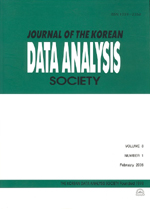인센티브지수를 이용한 지방재정자립도 변화 분석
Analysis on Effect of Incentive Index in Local financial Self-support
- 한국자료분석학회
- Journal of The Korean Data Analysis Society (JKDAS)
- Vol.7 No.6
-
2005.122111 - 2120 (10 pages)
- 5

지방자치단체의 재정부족과 재정력격차를 해소하기 위해 여러 가지 방법을 사용하고 있지만 만족할 만한 성과가 나타나지 않고 있다. 최근에는 소비세를 세원으로 하는 지방소비세의 도입을 위한 논의가 활발하다. 본고는 지방소비세의 도입을 가정하고 세원배분 방안으로 인센티브지수 방법을 도출하였다. 이를 통해 세원배분에 따른 지방자치단체의 재정자립도의 변화를 통해 지방재정의 확충과 도덕적 해이 문제를 해결하는 방안을 제시하고자 한 바 인센티브지수에 의한 재원배분은 다른 방법에 비해 자치단체의 노력에 따라 재원배분의 크기가 달라지므로 어느 정도 자치단체의 자구노력을 이끌어내면서 열악한 단체의 재정보전에 도움을 줄 수 있었다. 또한 자치단체간 배분이 이루어진 후의 재정자립도의 격차가 줄어드는 효과를 보이고 있어 지방재정의 균등화에도 일정 효과가 있는 방법으로 나타났다.
The introduction of local consumption tax, converting a part of national consumption tax source to local one was the core of discussion to improve weak finance of local governments by transferring a part of national tax to local tax. I intend to analyze expected allocations to each autonomy government and the level of financial balance in each category.My study is focused on reasonable allocation method establishment and avoidance of moral hazard through the increase of tax revenue, analyzing the effect of tax revenue increase and financial balance caused by the introduction of consumption tax and also by analyzing the changes in each local government caused by the introduction of incentive effort index. By doing this, I intend to search for the development of allocation method of local consumption tax through strengthening reasonable equality and sound incentive system to prevent the tendency of responsibility evasion in collecting tax and moral hazard caused by indifferent allocation. By the introduction of accomplishment system through incentive effort index, we can differentiate some local governments that don t try to survive by itself from the other local governments that take the responsibilities. By giving much more benefits to local governments like the latter, we can induce competitions in good faith among local governments.
I. 문제제기
II. 지방소비세 배분방식
III. 인센티브지수의 도입
IV. 인센티브지수의 효과분석
V. 결 론
참고문헌
(0)
(0)